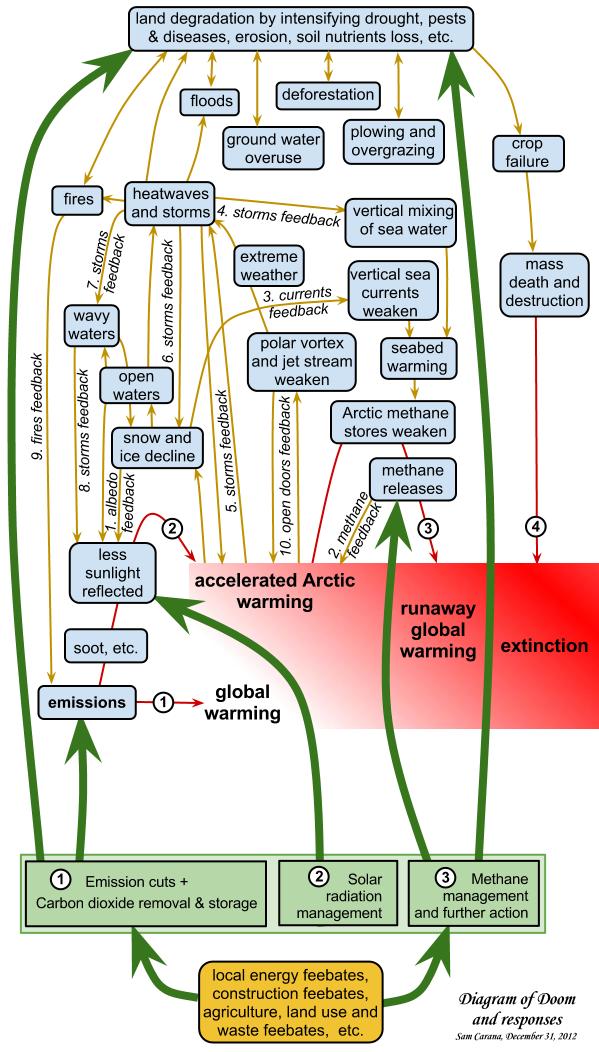 |
| Paul Beckwith, B.Eng, M.Sc. (Physics), Ph.D. student (Climatology) and Part-time Professor, University of Ottawa |
Rational decision making requires realistic risk assessments of alternatives. Humanity is now choosing default door A, which is no change in behavior with fossil fuel energy sourcing and a continuance of rapidly rising anthropogenic greenhouse gas emissions (GHGs).
Abrupt collapse of Arctic albedo due to collapsing terrestrial snow cover (area dropping 17.6% per decade for past three decades) and collapse of sea ice cover (area dropping 49% below 1979 to 2000 long term average) is occurring (NOAA 2012 Arctic Report Card from last week).
The destination is an ice free condition within a few years (by 2015 with PIOMAS volume projections); well before the 30 to 60 year timeframe of the most sophisticated climate change models which are a big FAIL on sea ice. The risk (= probability of occurrence x significance of occurrence) is enormous through door A. Probability of occurrence is 50% within 3 years and significance to human farming, water availability, temperatures and weather extremes is clearly massive.
 A recent widely-respected DARA report states that Today climate change is directly/indirectly reducing global GDP by 1.6% and attributing to 400,000 human deaths globally (to increase to 2.6% and 500,000 in about 20 years). A recent UN report is warning of global food shortages in 2013. There is no end in sight to the U.S. drought (climate models predict such droughts can last 20 or 30 years, hopefully they are wrong as they are with sea ice).
A recent widely-respected DARA report states that Today climate change is directly/indirectly reducing global GDP by 1.6% and attributing to 400,000 human deaths globally (to increase to 2.6% and 500,000 in about 20 years). A recent UN report is warning of global food shortages in 2013. There is no end in sight to the U.S. drought (climate models predict such droughts can last 20 or 30 years, hopefully they are wrong as they are with sea ice). I prefer door B - create an Anthropogenic Arctic volcano to calm the climate. Give me two large airplanes with pilots, some sulfur in solution, and a few large nozzles from your local ski hill; they are not needed anyway since the ski industry has estimated losses of $1 Billion over the last decade (about 8% of total revenues); adaptation to zip lining and water parks is possible. With this equipment I will fly into the stratosphere (above the weather) near the North Pole and spread sulfur dust/aerosols to reflect incoming sunlight and rapidly cool the Arctic for several years. This will restore sea ice, straighten the jet streams, and restore a “normal” climate.
Very little sulfur is needed relative to huge emissions from smokestacks into the lower atmosphere from coal burning power plants. It will work; powerful erupting volcanoes that aim upwards (like Pinatubo in 1991) and not sideways (like Mt. St. Helens in 1980) have cooled the climate by a degree or more for 2 to 3 years. They do this by injecting sulfur up into the upper atmosphere, like our aircraft will do.
Door B has two important sub-doors, B-Bad and B-Good. Door B-B is using the sulfur injections to calm climate and continuing the fossil-fuel energy sourcing with rapidly accelerating GHGs. This door will be a false reprieve since the GHGs will continue to rapidly acidify the ocean and destroy the base of the food chain; by the way, ocean phytoplankton levels have dropped 40% since 1950.
 |
| Wikipedia image: UN jet with humanitarian relief supplies |
Of course there is a caveat with Door B-G. We must start the sulfur injections when the sun rises in the Arctic in the spring in early 2013. Waiting for more sea ice collapse will decrease the odds of success at obtaining Arctic snow cover and sea ice regrowth. Give me a plane, pilot, nozzle, and sulfur and I can calm the climate.
Originally posted January 10, 2013, at Sierra Club Canada; posted here with author's permission












